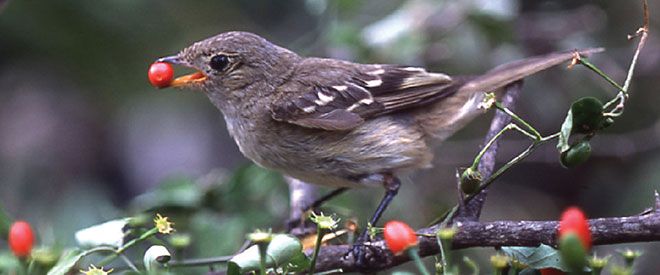Bird Gut Boosts Wild Chili Seed Survival

(ISNS) -- When a South American bird eats a certain wild chili pepper, its gut changes the seeds in ways that may improve the seeds' chances of growing into new pepper plants, a new study suggests.
Seeds of the wild chili plant Capsicum chacoense that passed through the gut of the Small-billed Elaenia had fewer pathogens and ant-attracting chemical cues, giving them a 370 percent increase in survival rate, according to Evan Fricke, a graduate student at the University of Washington, in Seattle.
Native to Bolivia, Argentina and Paraguay, C. chacoense -- the plant in the study -- produces spicy, red-colored peppers. The Small-billed Elaenia commonly grazes on the peppers, and after digesting them, disperses the seeds around the environment giving the peppers an opportunity to flourish. But the peppers do face a few challenges to survival. Insects can pass fungal infections to the seeds, and ants can pick up and presumably eat the seeds after they are dispersed.
The study, published in the journal Ecology Letters, tested for three factors that could affect the seeds' survival: chemicals from the seeds that attract ants, the seeds' distance from the parent plant, and the seeds' fungal load -- the amount of fungal infection on the seed's outer covering.
They found that seeds that passed through a bird's digestive system had a 31 percent lower fungal load in lab tests and were twice as likely to survive in natural field conditions as unprocessed seeds that were taken directly from the pepper.
Ants picked up the bird-processed seeds only half as many times as unprocessed seeds in the first two days, after which the removal rates were almost identical. The researchers believe that unprocessed seeds emit volatile chemicals that make them more attractive to local ants, while the bird's gut "conditions" the other set of seeds, changing their characteristics and making them less attractive.
Ants removed both sets of seeds at similar rates after the first couple of days, but initially the seeds that the birds processed were ignored by ants in favor of unprocessed seeds. That initial edge seemed to boost the final number of processed seeds that germinated, according to Fricke.
Sign up for the Live Science daily newsletter now
Get the world’s most fascinating discoveries delivered straight to your inbox.
"At the very end, it is still a doubling of survival," he said.
The researchers also tested the assumption that seeds far away from the parent fare better, as ants tend to concentrate near the parent plant where more seeds fall.
In their experiments, however, they found that distance did little to reduce the seeds' removal rate. In fact, the farther away the seeds were from their parent plant, the higher chance they had of being eaten by the ants. One of the reasons, Fricke guessed, could be "predator satiation" -- a phenomenon in which the ants become "full" quickly when too many seeds fall near the parent, giving the seeds a sort of safety-in-numbers advantage.
Scientists have studied plant-bird interactions for decades, trying to address how plants benefit from the relationship, Fricke said. "It's fairly easy to answer from the birds' side: they're getting dinner out of it. The main goal was to figure out all the ways the bird was benefiting the plant."
The study has "important implications for understanding the complexity of the interactions between seed dispersers and the plants," according to Eugene Schupp, an ecologist at Utah State University, in Logan, who was not involved with the research.
People have studied the effect of the digestive process on seed germination rates before, but not on seed removal by ants or mortality due to fungi as this study did, Schupp added.
The next step is to see if other plants have similar mechanisms for conditioning and protecting their seeds that the chili peppers employ through the Small-billed Elaenia's gut.
"They [the birds] certainly seem to be extremely important in this chili pepper, and could potentially be important in other dispersal systems as well," Schupp said.
Inside Science News Service is supported by the American Institute of Physics. Ranjini Raghunath is a science writer in Mountain View, California.













